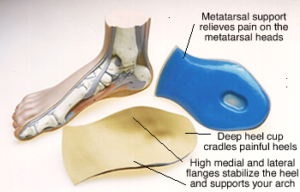Any one who has even experienced the pain associated with plantar fasciitis (heel or arch pain) can tell you how this common foot condition can negatively impact your work and everyday lifestyle. Use these four proven therapies for plantar fasciitis relief
The term Plantar Fasciitis is derived from the words plantar referring to the bottom of the foot and fascia which is a fibrous tissue that attaches to the bottom of the heel bone and extends forward to the toes. Plantar Fasciitis is simply referring to inflammation of the fascia. This is a very common condition that will affect approximately 1 out of every 8 people in their lifetime. The typical symptoms are a burning pain and irritation just forward of the calcaneus (heel bone) and sometimes leading to the arches of your feet. Pain is usually intensified after a period of rest, such as sleep or extended periods of sitting (driving home from work, after sitting down for lunch or dinner). When you stand up after periods of rest the pain can be intense and sometimes last throughout the day.
Luckily for most of us (about 95%) we can get relief from 4 simple proven therapies. All of these treatments must be done at the same time with consistency and any meager attempts will usually yield meager results.
Therapy # 1 – Orthotics and Plantar Fasciitis
Foot orthotics are a common and the most effective treatment for many types of foot disorders, including plantar fasciitis. The purpose of a foot orthotic is to brace or support the  bones and connective tissue of the foot. Supporting the foot with orthotics can realign the structure of the foot, ankle and leg to prevent bone misalignment as well as muscle, ligament and tendon fatigue. Orthotics designed for plantar fasciitis should properly support all three arches in the foot (medial, lateral and transverse arch). With proper support of the foot, stress and tension on the plantar fascia will be greatly reduced. This will allow an injured or torn plantar fascia to heal. In addition, orthotics allow for more even weight distribution, taking pressure off sore spots (e.g. the heels, arches and the ball of the foot). The main purpose of a foot orthotic is to improve foot function, and in most cases reducing pain and preventing re-injury.
bones and connective tissue of the foot. Supporting the foot with orthotics can realign the structure of the foot, ankle and leg to prevent bone misalignment as well as muscle, ligament and tendon fatigue. Orthotics designed for plantar fasciitis should properly support all three arches in the foot (medial, lateral and transverse arch). With proper support of the foot, stress and tension on the plantar fascia will be greatly reduced. This will allow an injured or torn plantar fascia to heal. In addition, orthotics allow for more even weight distribution, taking pressure off sore spots (e.g. the heels, arches and the ball of the foot). The main purpose of a foot orthotic is to improve foot function, and in most cases reducing pain and preventing re-injury.
Therapy # 2 – Proper stretching
In most cases people who suffered from plantar fasciitis could significantly cut their healing time by stretching for as little as ten minutes a day. The proper stretches should only include non-weight bearing stretching. What is a non weight bearing stretch? Simply it is any stretching exercise that is not performed in a standing or weight bearing position.
Therapy # 3 – Icing
The word fasciitis simply refers to inflammation of the plantar fascia. Like many soft tissue injuries, the injured tissue will become more inflamed as the day progresses. This is due to our daily activities and the repetitive stress that your feet are subjected to throughout the day. At the end of each day take a frozen bottle of water and place it on the floor in front of you. While sitting in a chair, roll the bottle back and forth on the bottom of your foot. Continue the icing for 4-5 minutes for each foot.
Therapy # 4 – Wearing the proper shoes

When selecting shoes for heel pain always buy a lace up shoe. Start by examining the outsole of the shoe. The outsole should be moderately firm to hold your bodies weight during running. To test the outsole try to bend the shoe in half, the shoe should not collapse in the middle. If the shoe just bends in half with little or no effort then it will not hold up under forces of your body weight. Next, test the heel counter of the shoe. Grab the back portion of the shoe and squeezing the heel counter. If the material around the heel collapses then it is a poor design. The heel counter should be firm to your grip. A firm heel counter will keep your heel aligned properly. It will also control pronation and supination. Beware of marketing gimmicks such as air, springs or any other crazy ideas that the shoe companies dream up. These gimmick shoes have created many problems and will not help with most foot conditions. Just remember, what is best is a good solid foundation for you to walk on. A flimsy sole that will collapse under weight of your body.
Disclaimer: Consult your doctor if you feel you have a medical problem.
